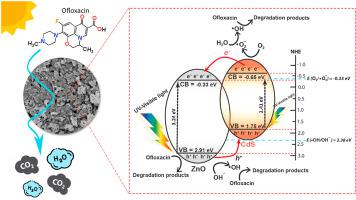当前位置:
X-MOL 学术
›
Mater. Sci. Semicond. Proc.
›
论文详情
Our official English website, www.x-mol.net, welcomes your feedback! (Note: you will need to create a separate account there.)
Visible-light-responsive photocatalyst based on ZnO/CdS nanocomposite for photodegradation of reactive red azo dye and ofloxacin antibiotic
Materials Science in Semiconductor Processing ( IF 4.1 ) Pub Date : 2021-03-01 , DOI: 10.1016/j.mssp.2020.105558 Teeradech Senasu , Tammanoon Chankhanittha , Khuanjit Hemavibool , Suwat Nanan
Materials Science in Semiconductor Processing ( IF 4.1 ) Pub Date : 2021-03-01 , DOI: 10.1016/j.mssp.2020.105558 Teeradech Senasu , Tammanoon Chankhanittha , Khuanjit Hemavibool , Suwat Nanan

|
Abstract Fabrication of ZnO/CdS nanocomposite with addition of sodium dodecyl sulphate (SDS) has been demonstrated. The ZnO photocatalyst was synthesized first by precipitation route and then the CdS photocatalyst was decorated on the surface of the ZnO via a hydrothermal technique. The PL intensity of the ZnO/CdS nanocomposite was lower than that obtained from ZnO. This indicates lower electron-hole recombination rate implying the improvement of photoactivity. The composite showed efficiency of 80% and 73% toward photodegradation of reactive red 141 (RR141) azo dye and ofloxacin (OFL) antibiotic, respectively. This is attributed to its high specific surface area together with suppression of charge carrier recombination. The efficiency of OFL degradation also reached 90% under solar light. The structural stability of the photocatalyst after three runs has been confirmed. The photogenerated hole played a crucial role in photodegradation of OFL antibiotic. The prepared ZnO/CdS photocatalyst shows a promising potential for environmental protection.
中文翻译:

基于ZnO/CdS纳米复合材料的可见光响应光催化剂用于光降解活性红色偶氮染料和氧氟沙星抗生素
摘要 已证明添加十二烷基硫酸钠 (SDS) 可制备 ZnO/CdS 纳米复合材料。首先通过沉淀法合成ZnO光催化剂,然后通过水热技术将CdS光催化剂装饰在ZnO表面。ZnO/CdS 纳米复合材料的 PL 强度低于从 ZnO 获得的。这表明较低的电子-空穴复合率意味着光活性的提高。该复合材料对活性红 141 (RR141) 偶氮染料和氧氟沙星 (OFL) 抗生素的光降解效率分别为 80% 和 73%。这归因于其高比表面积以及电荷载流子复合的抑制。在太阳光下,OFL的降解效率也达到了90%。已经证实了三轮运行后光催化剂的结构稳定性。光生空穴在OFL抗生素的光降解中起着至关重要的作用。所制备的 ZnO/CdS 光催化剂在环境保护方面具有广阔的前景。
更新日期:2021-03-01
中文翻译:

基于ZnO/CdS纳米复合材料的可见光响应光催化剂用于光降解活性红色偶氮染料和氧氟沙星抗生素
摘要 已证明添加十二烷基硫酸钠 (SDS) 可制备 ZnO/CdS 纳米复合材料。首先通过沉淀法合成ZnO光催化剂,然后通过水热技术将CdS光催化剂装饰在ZnO表面。ZnO/CdS 纳米复合材料的 PL 强度低于从 ZnO 获得的。这表明较低的电子-空穴复合率意味着光活性的提高。该复合材料对活性红 141 (RR141) 偶氮染料和氧氟沙星 (OFL) 抗生素的光降解效率分别为 80% 和 73%。这归因于其高比表面积以及电荷载流子复合的抑制。在太阳光下,OFL的降解效率也达到了90%。已经证实了三轮运行后光催化剂的结构稳定性。光生空穴在OFL抗生素的光降解中起着至关重要的作用。所制备的 ZnO/CdS 光催化剂在环境保护方面具有广阔的前景。



























 京公网安备 11010802027423号
京公网安备 11010802027423号